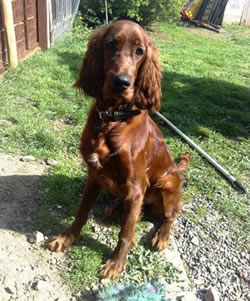Irish Setter

"Missie" 5 month old Irish Setter pup |
Photo with thanks to
Cathy, www.perfidelis.co.uk
|
See more Irish Setter Pictures and Puppy Pics
Irish Setter
Breeders & Puppies For Sale If your
a Irish Setter breeder and have Irish Setter puppies for sale, send us your details for free and we will add to our Irish Setter Breeders page.
Irish Setter
Rescue Center Visit the Irish Setter rescue centers if your looking to rescue a Irish Setter, as well as learn more about the breed or just support the rescue centers for there hard work.
Group Gundogs (KC)
Origin /
History The Irish Setter was developed from the Irish Red and White, an older breed of almost identical use and character. It is usually distinguished by its rich red coat, which proved more valuable in the field than its spotted cousin. Its name in Irish Gaelic is “Madra Rua,” which means “red dog.” Its exact ancestry is unknown, but it is generally believed to be a mix between the English Setter, Irish Terrier, Pointer, Spaniel, and Gordon Setter.
The Irish Setter’s sporting skill, coupled with its attractive coat, quickly earned the approval of breeders and sportsmen. The breed started gaining popularity around 1850, and within the next hundred years became a hunting favorite not only in its native Ireland but also throughout Britain and neighboring countries. Before long, breeders started importing the dogs to the US, and the Irish Setter was recognized by the American Kennel Club in 1878.
Appearance The Irish Setter has a medium to large body covered by a rich, glossy coat. The coat covers most of the body except the head, where it grows shorter and finer. Its tail is heavily fringed and carried horizontally. The ears are proportionally long, well-feathered and soft. Irish Setters should be well-boned; females can have a more feminine build, but never appear light or dainty. Sizes vary by purpose: show dogs usually weigh about 70 pounds, while working dogs are kept at around 45 pounds for better agility.
Colours Acceptable colors range from mahogany to chestnut red, with no black anywhere on the body. Small white markings are allowed on the head, throat, chest and toes.
Temperament Irish Setters are friendly and outgoing, seldom shy but sometimes reserved around strangers. They get along well with almost anyone, but are particularly attached to children. Some are a little high-strung, but a little petting and cuddling should calm them down. They can also be a bit sensitive, so owners should take care not to offend them or scold them too harshly. These dogs are very intelligent and make excellent companions around the house.
Height and
Weight 61 - 71 cm in height and 25 - 34 Kg in weight. Males are larger than females and at the top end of the size ranges.
Common Health
Problems Irish Setters are prone to bloat or gastric torsion, wherein the stomach becomes distended and rotates. To avoid this, they should be fed several small meals throughout the day instead of a few big ones. Skin allergies are also a problem because of their dense coats. As with most medium to large breeds, they are also prone to hip dysplasia, elbow dysplasia, and other bone problems.
Living Conditions These dogs love the outdoors; they aren’t built for apartment or city life. The ideal home is one with a large, well-fenced yard where they can run free. They are easily bored, so it’s important to keep them occupied lest they become restless or destructive. They are sturdy enough to sleep outdoors, but most dogs would rather sleep with their family.
Exercise
Requirements Irish Setters are very energetic and need a lot of exercise to stay that way. Apart from daily walks or jogs, they should also be allowed to run off the leash once in a while. Be sure to do so in a fenced area, though—many dogs have been lost or killed while chasing prey. Whenever possible, take them on family outings so they can swim and romp occasionally.
Training Requirements This breed is said to be slow-witted, but they are in fact very trainable and can learn any number of tasks. They are best trained to be working dogs, as they love spending long hours bonding with the family. Calm and gentle training works best, but owners must be firm enough to establish dominance. Socialization is helpful but not necessary, since Irish Setters are naturally friendly.
Life Expectancy Irish Setters live an average of 11 to 15 years..
Grooming The Irish Setter’s coat should be brushed daily to keep it soft and flat. The fur tends to tangle at the limbs and ears, so extra attention should be given to these parts. This breed sheds moderately and should be groomed more often during shedding season. The coat is naturally sleek, so baths can be given only when needed.
Famous Examples
CompleteDogsGuide Comment
Breeders
Comments: Send us yours comments, advice for owners, potential owners etc.
Owners Comments: Send us any of your comments. Thanks in advance.
More Irish Setter Information: Check out our Irish Setter Clubs and links to more informative websites dedicated to the breed.
Submit your Irish Setter pictures Send us any pics of your Irish Setter, let us know there name and age and any other details. We'll add to this page. Contact us
| Irish Setter Photos |
 "Belle" 6 month old Irish Setter
|

"Finley" & "Fraser" |
|

"Jess" |

"Jess" carrying a bottle |
|